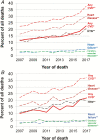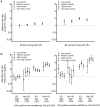Sex- and Poverty-Specific Patterns in Cardiovascular Disease Mortality Associated With Human Immunodeficiency Virus, New York City, 2007-2017
- PMID: 31504325
- PMCID: PMC7384322
- DOI: 10.1093/cid/ciz852
Sex- and Poverty-Specific Patterns in Cardiovascular Disease Mortality Associated With Human Immunodeficiency Virus, New York City, 2007-2017
Abstract
Background: Human immunodeficiency virus (HIV) may affect the risk of death due to cardiovascular disease (CVD) differently in men versus women.
Methods: We examined CVD mortality rates between 2007 and 2017 among all New York City residents living with HIV and aged 13+ by sex, using data from city HIV surveillance and vital statistics and the National Death Index. Residents without HIV were enumerated using modified US intercensal estimates. We determined associations of HIV status with CVD mortality by sex and neighborhood poverty, defined as the percent of residents living below the federal poverty level, after accounting for age, race/ethnicity, and year.
Results: There were 3234 CVD deaths reported among 147 915 New Yorkers living with HIV, with the proportion of deaths due to CVD increasing from 11% in 2007 to 22% in 2017. The age-standardized CVD mortality rate was 2.7/1000 person-years among both men and women with HIV. The relative rate of CVD mortality associated with HIV status was significantly higher among women (adjusted rate ratio [aRR] 1.7, 95% confidence interval [CI] 1.6-1.8) than men (aRR 1.2, 95% CI 1.1-1.3) overall, and within strata defined by neighborhood poverty. Sex differences in CVD mortality rates were the greatest when comparing individuals living with HIV and having detectable HIV RNA and CD4+ T-cell counts <500 cells/uL with individuals living without HIV.
Conclusions: Among people with HIV, 1 in 5 deaths is now associated with CVD. HIV providers should recognize the CVD risk among women with HIV, and reinforce preventive measures (eg, smoking cessation, blood pressure control, lipid management) and viremic control among people living with HIV regardless of neighborhood poverty to reduce CVD mortality.Human immunodeficiency virus (HIV) increases cardiovascular disease mortality risks to a greater degree among women than men, even after accounting for neighborhood poverty. HIV providers should emphasize cardiovascular disease prevention (eg, smoking cessation, hypertension control, lipid management) and viremic control.
Keywords: HIV infection; cardiovascular disease; mortality; poverty areas; women.
© The Author(s) 2019. Published by Oxford University Press for the Infectious Diseases Society of America. All rights reserved. For permissions, e-mail: journals.permissions@oup.com.
Figures


References
-
- Kaplan RC, Kingsley LA, Sharrett AR, et al. . Ten-year predicted coronary heart disease risk in HIV-infected men and women. Clin Infect Dis 2007; 45:1074–81. - PubMed
Publication types
MeSH terms
Grants and funding
LinkOut - more resources
Full Text Sources
Medical
Research Materials

